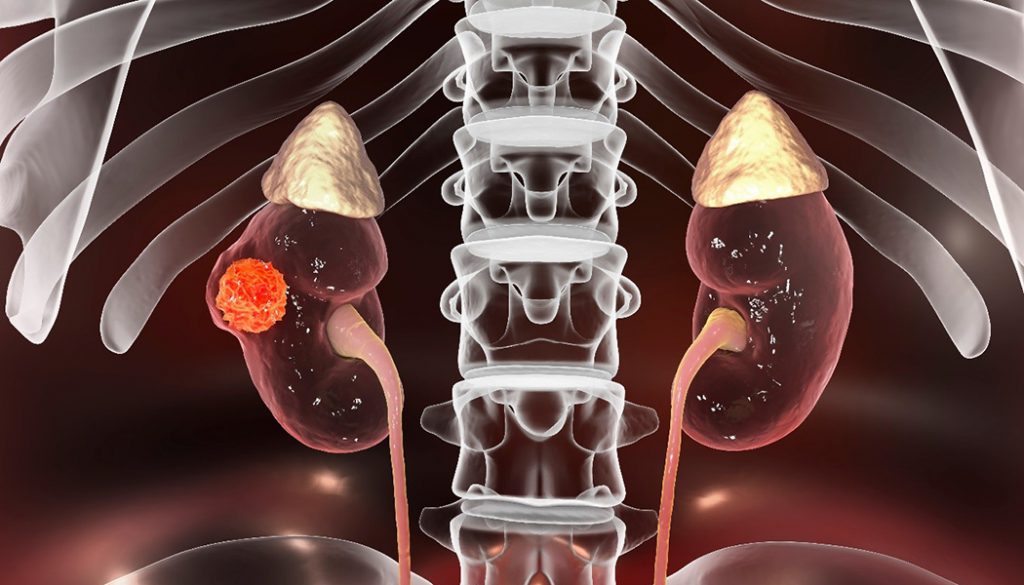Kidney Cancer Detection Advances
About 73,820 new cases of kidney cancer are forecast to be diagnosed among Americans in 2019, and nearly 14,770 can be expected to die from the disease. Cancer of the kidneys, like any cancer, is most curable at an early stage. However, the majority of early-stage tumors do not present symptoms. In fact, many cases are discovered “by accident” during imaging for a range of other health conditions, by which point tumors have proceeded to advanced stages. But researchers in the United Kingdom recently identified a protein marker in the blood that could act as warning beacon five years in advance of the current standard of detection.
When the molecule, called KIM-1, occurs in greater concentrations, the scientists found, the higher the risk is of developing kidney cancer. KIM-1 levels were also found to be linked with poor survival of the disease, as those with the highest levels in their blood were less likely to live. In the future, the scientists think that testing for blood KIM-1 levels could be used alongside imaging to confirm suspicions of kidney cancer, or help to rule out the disease.
KIM-1, short for “kidney injury molecule-1,” is a type-1 transmembrane protein and is not normally present, but is expressed with injury. KIM-1 has proved to be an outstanding indicator of kidney injury in rat trials, outperforming blood urea nitrogen and serum creatinine levels as predictors of histopathological changes in the proximal tubule (part of the kidney’s filtration structure) in response to many pathophysiological states or toxicants. Previous to the British research, studies in humans strongly suggested that tissue expression and urinary excretion of KIM-1 are specific markers of injury, as well as predictors of outcome.
“This work is a big step forward,” said Dr. David Muller of Imperial College London. “KIM-1 is the only blood biomarker shown prospectively to distinguish between people at high and low risk of kidney cancer. The next steps are to look more closely at whether KIM-1 levels can help detect tumors that have a good prognosis.”
Professor Charles Swanton, Cancer Research UK’s Chief Clinician, adds: “The potential of blood tests for the detection and monitoring of cancers is becoming increasingly apparent, and this work offers further evidence that they could become powerful tools in the clinic. There is a pressing need to shift kidney cancer diagnoses towards earlier stages, when treatment is more likely to be successful, and this promising research is progress towards that goal. This work is still in early stages, so prospective studies of larger populations are needed before this approach could be widely adopted.”
“It’s now crucial to understand more about how KIM-1 could be incorporated into patients’ treatment,” comments Dr. Rural Bhatt, a senior author based at Harvard Medical School. “We’re excited about progressing this important work further and testing whether KIM-1 levels could help identify patients who may benefit from additional treatment after surgery, and therefore potentially improve their outlook.”
Cancer markers in the blood comprise an expanding and exciting field. Such NFCR fellows as Daniel Haber, Ph.D., and Wei Zhang, Ph.D., are leading figures. More advances seem to be around the corner, and support by donors will continue to make this possible.
References:
- American Cancer Society. (2019). Key Statistics About Kidney Cancer. Retrieved from: https://www.cancer.org/cancer/kidney-cancer/about/key-statistics.html
- Bonaventre, JV. (2009). Kidney Injury Molecule-1 (KIM-1): a specific and sensitive biomarker of kidney injury. Retrieved from: https://www.tandfonline.com/doi/abs/10.1080/00365510802145059?journalCode=iclb20
- Cancer Research UK. (2018). Blood test could detect kidney cancer up to 5 years earlier. Retrieved from: https://www.cancerresearchuk.org/about-us/cancer-news/press-release/2018-08-13-blood-test-could-detect-kidney-cancer-up-to-5-years-earlier












